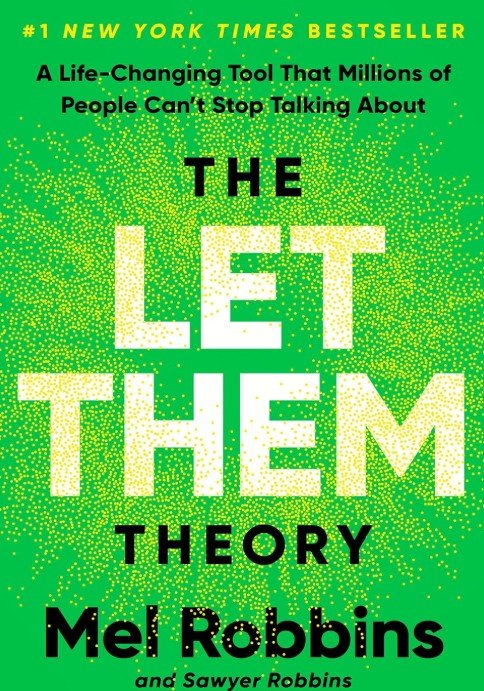The Life-Changing Power of the Let Them Theory: Two Words That Set You Free
The On Purpose Podcast with Mel Robbins | November 6, 2025
We spend so much of our lives trying to control things that were never meant to be controlled—people, outcomes, moods, reactions, even timing. We want others to act how we expect, situations to unfold the way we plan, and life to match our vision. When it doesn’t, we push harder, overthink, and wear ourselves out trying to make things fit.
The truth is, most of our stress doesn’t come from what’s happening around us—it comes from resisting what we can’t change. And that’s where the Let Them Theory becomes a quiet revolution.
Two small words. One big shift.
Let them.
It’s simple, but not easy. It’s a mindset that can help you release control, regain peace, and rediscover your power.

The Root of Stress — Trying to Control the Uncontrollable
Think about how many of your daily frustrations involve other people’s choices or attitudes. The coworker who takes credit for your work. The partner who leaves dishes in the sink. The friend who forgets to call back.
We try to manage, correct, and explain because control makes us feel safe. It creates the illusion of order in a world that’s often unpredictable. But when we try to control what’s outside of us, we drain the energy we could be using to grow, create, or simply enjoy being alive.
Here’s the truth: peace doesn’t come from fixing others—it comes from focusing on yourself. You can’t stop someone from being rude, dismissive, or lazy. You can’t make people appreciate you, understand you, or meet your expectations. But you can always choose how you respond.
That’s the freedom of Let Them.
What the Let Them Theory Really Means
At its core, this mindset is about recognizing the line between what’s yours to manage and what isn’t.
When someone’s behavior frustrates you, instead of reacting or trying to fix it, you quietly say to yourself: Let them.
Let them think what they want.
Let them act how they choose.
Let them miss out, if that’s what they decide.
It’s not a passive surrender—it’s an act of empowerment. You’re not ignoring the situation; you’re refusing to let it control your emotional state. You’re acknowledging that their choices belong to them, and your peace belongs to you.
That single pause—those two words—can turn emotional chaos into clarity.
"Let Them" vs "Let Go"
| Concept | Let It Go | Let Them |
|---|---|---|
| Mindset | Releasing attachment | Allowing others to act freely |
| Focus | Your emotions | Their behavior and your response |
| Feeling | Acceptance | Empowerment |
| Energy | Passive (“I surrender”) | Active (“I choose peace”) |
| Result | Temporary calm | Lasting emotional control |
“Let It Go” feels like release.
“Let Them” feels like freedom.
While “letting it go” helps you move on, “letting them” helps you detach from the illusion of control. You stop giving your emotional energy to people who haven’t earned it, and you start directing that energy toward what you can influence—your reactions, your thoughts, your next step.
Turning Frustration into Freedom
The Let Them mindset can be applied almost anywhere in life. Imagine your workplace, for example. A coworker takes credit for something you did. The urge to call them out or prove yourself might rise immediately—but what if, instead, you just said Let them? Let them take the spotlight. Let them reveal their character. You keep focusing on excellence, knowing that integrity has a way of shining through.
At home, it’s the same principle. Maybe your partner forgets a small responsibility, or your teenager tunes you out. Before you react, pause and whisper Let them. It doesn’t mean you won’t address the issue later—it means you won’t let irritation steal your peace in the moment.
Even online, this mindset is liberating. You post something meaningful, but someone criticizes it. Let them. Everyone has an opinion, and not all opinions are worth your energy. You can’t control their perception, but you can control how much weight you give it.
Let them judge. Let them gossip. Let them misunderstand.
You’ll stay centered, calm, and confident.
The “Let Me” Response — Taking Back Your Power
Once you’ve released what’s not yours, the next step is to return to what is. After saying Let them, shift gently into Let me.
Let me focus on what I can control.
Let me decide how to respond.
Let me stay calm and grounded.
There are only three things we truly control in this life: our thoughts, our actions, and our emotions. When you keep your attention on those, everything else starts to feel lighter.
The Three Circles of Control
| What You Can Control | Examples | Why It Matters |
|---|---|---|
| Your Thoughts | How you interpret events | Creates clarity and perspective |
| Your Actions | What you choose to do or say | Builds confidence and integrity |
| Your Emotions | How you process feelings | Brings calm and resilience |
By focusing on your own circle of control, you stop wasting emotional energy trying to change what isn’t yours. You become calmer, clearer, and stronger—and that inner stability ripples through every part of your life.
Relationships and Boundaries
One of the most powerful applications of this theory is in relationships. We often tie our happiness to other people’s behavior—hoping they’ll change, listen, care more, or finally understand us. But when you stop trying to make people be different and start letting them be who they are, something beautiful happens: you see them clearly.
Let them show you who they are.
If they want to make the effort, they will. If they don’t, that’s your answer.
You no longer need to chase, convince, or explain. Love becomes lighter, more honest, and far less painful. Because real peace doesn’t come from control—it comes from clarity.
Let them be who they are.
Let me respond with love, strength, and boundaries.
Your Energy Is Currency — Spend It Wisely
Every thought, worry, or emotional reaction costs energy. If your mental energy were money, how much would you spend replaying old arguments, scrolling through negative comments, or trying to fix other people’s moods?
Your attention is your most valuable asset. Don’t spend it on what doesn’t grow you.
When you notice yourself spiraling—replaying what someone said, imagining what you should’ve said back—pause and repeat: Let them. Then redirect your energy to something productive: your work, your hobbies, your healing.
Peace is expensive, but it’s worth every ounce of awareness it takes to protect it.
Friendships, Family, and Letting Life Flow
Friendships and family dynamics are where this mindset is tested the most. You might feel like you’re always the one calling, checking in, or planning gatherings. It’s easy to interpret that imbalance as rejection. But maybe it’s not rejection—it’s reality.
People have different capacities, timelines, and seasons. Adulthood spreads us thin.
If a friend stops reaching out, let them. If family doesn’t always show up, let them. It’s not about giving up—it’s about understanding that everyone is doing the best they can with what they have.
You can love people without needing to control their availability. You can be open without being attached. That’s emotional freedom.
When you stop keeping score, relationships stop feeling like battles—and start feeling like choices.
Love Without Control
Letting someone face their own struggles can feel uncomfortable, especially when you care deeply. But love that tries to rescue becomes control in disguise. True compassion says: I believe in your ability to grow through this.
Support doesn’t always mean fixing. Sometimes it means sitting beside someone in silence, holding space for them to find their strength. Let them stumble, let them learn, and trust that they’ll rise stronger.
That’s not indifference—it’s respect.
Healing and Moving Forward
Few moments test this theory more than heartbreak. When someone walks away or betrays your trust, your mind races for answers. You want closure, an explanation, or a sign that it mattered.
But healing begins when you whisper, Let them go.
Let them take their path. Let them show you who they are. Let me use this pain to grow.
It’s not about pretending it doesn’t hurt—it’s about trusting that pain has purpose. Every time you resist chasing closure, you open a doorway to peace.
One powerful exercise: give yourself 30 days without checking their social media or rereading old messages. Your nervous system will begin to reset. By the time a month passes, you’ll notice you’ve stopped waiting—and started healing.
That’s the quiet strength of letting go.
Let Them Succeed
When we compare ourselves to others, we’re trying to control something we never can: the pace of our own journey. But someone else’s success doesn’t diminish yours. It illuminates what’s possible.
Let them succeed. Let them win, shine, and grow. Their story doesn’t compete with yours—it inspires it.
The world is abundant. There’s room for all of us to flourish. The more we celebrate others, the more open we become to abundance ourselves.
How to Practice Every Day
Start small. When something irritates you, pause before reacting. Whisper “Let them” as a gentle reminder that peace is a choice. Then follow it with “Let me”—and bring your focus back to what you can control.
Protect your emotional energy like it’s gold. Celebrate the clarity that comes from seeing things—and people—for what they truly are.
Each time you do, you strengthen a muscle that leads to deep emotional freedom.
The Freedom of Letting Them
The Let Them Theory isn’t about detachment or apathy. It’s about wisdom. It’s about finally understanding that the only thing you ever truly own is your response.
When you let people be who they are, you also give yourself permission to be who you are. You stop forcing, fixing, and proving. You start flowing, creating, and choosing peace over chaos.
So the next time someone disappoints you, ignores you, or simply acts out of alignment with your values, take a breath and say:
“Let them.”
Then remind yourself softly,
“Let me stay calm, grateful, and free.”
Two words. One shift.
A lifetime of peace.

The Let Them Theory
Feeling drained by other people’s opinions or expectations? The Let Them Theory by Mel Robbins shows how two simple words—Let Them—can free you from stress and help you focus on what truly matters: yourself. Discover the mindset that’s changing lives—check out the book and start reclaiming your peace today.
Related Post


